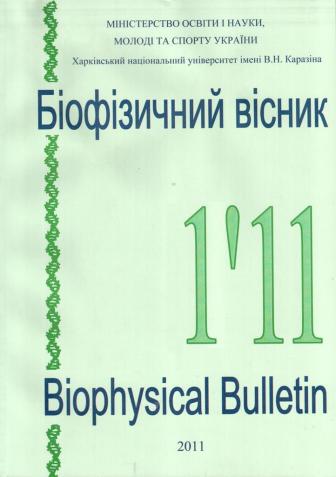Complex formation of aromatic biologicaly active compounds with antibiotic topotecan: analysis by means of 1h nuclear magnetic resonance spectroscopy
Abstract
In the present work with use of 1H NMR spectroscopy data the analysis of heteroassociation of antibiotic
topotecan (TPT) with aromatic biologically active compounds (BAC): caffeine, mutagens ethidium
bromide and proflavine, antibiotic daunorubicin, vitamins flavin-mononucleotide and nicotinamide, is
carried out. The analysis was performed taking into account the existence of the antibiotic in aqueous
environment under physiological pH in two various forms – lactone and carboxylate. Equilibrium
constants of heteroassociation and induced chemical shifts of TPT protons (in lactone and carboxylate
forms) and the BACs within the complexes were obtained. It is found that the complex formation TPTBАС is characterized by the stacking of the chromophores and additionally stabilized in case of
proflavine by intermolecular hydrogen bond
Downloads
References
2. Graves D.E., Velea L.M. Intercalative binding of small molecules to nucleic acids // Curr. Org. Chem. - 2000. - V.4. - P.915-928.
3. Evstigneev M.P. DNA-binding aromatic drug molecules: Physico-chemical interactions and their biological roles. - Lambert Academic Publishing., 2010. - 96 p.
4. Traganos F., Kapuscinski J., Gong J., Ardelt B., Darzynkiewicz R. J., Darzynkiewicz Z. Caffeine prevents apoptosis and cell cycle effects induced by camptothecin or topotecan in HL-60 cells // Cancer Res. – 1993. – V.53. – P.4613 - 4618.
5. Лантушенко А.О., Мосунов А.А., Даржинкевич З., Евстигнеев М.П. Протекторное действие витамина B2 по отношению к антибиотику топотекану in vitro // Физика живого. – 2007. – Т.15. – С.18-23.
6. Bernacki R.J., Pera P., Gambacorta P., Brun Y, Greco W.R. In vitro antitumour activity of 9-Nitro-camptothecin as a single agent and in combination with other antitumour drugs // Ann. N.Y. Acad. Sci. -2000. - P.293-297.
7. Gabr A., Kuin A., Aalders M. Cellular pharmacokinetics and cytotoxicity of camptothecin and topotecan at normal and acidic pH // Cancer Res. – 1997. – V.57. – P.4811-4816.
8. Mazzini S., Bellucci M.C., Dallavalle S., Fraternali F., Mondelli R Mode of binding of camptothecins to double helix oligonucleotides // Org. Biomol. Chem. – 2004. – V.2. – P.505-513.
9. Bocian W., Kawecki R., Bednarek E., Sitkowski J., Pietrzyk A., Williamson M.P., Hansen P. E., Kozerski L. Multiple binding modes of the camptothecin family to DNA oligomers // Chem. Eur. J. – 2004. – V.10. – P. 5776-5787.
10. Бучельников А.С., Евстигнеев В.П. Моделирование многокомпонентного равновесия биологически активных ароматических молекул в водном растворе // Вестник СевНТУ (серия Физика и математика). – 2009. – Вып. 99. – С.3-11.
11. Мосунов А.А., Симонова С.Н., Розвадовская А.О. Исследование самоассоциации антибиотика топо-текана // Вестник СевГТУ (серия Физика и математика). – 2007. – Т.85. – С.54-58.
12. Evstigneev M.P., Evstigneev V.P., Davies D.B. A method for analysis of multicomponent systems of inte-racting aromatic molecules in solution // J. Chem. Phys. – 2007. – V. 127. – P. 154511-7.
13. Евстигнеев В.П., Мосунов А.А., Евстигнеев М.П. Решение задачи об одномерной некооперативной самосборке невалентного типа в двухкомпонентной системе // Хим. физика (направлена в печать).
14. Евстигнеев В.П. Многокомпонентные взаимодействия ароматических биологически активных соеди-нений и ДНК в водном растворе: дис. кандидата физ.-мат. наук: 03.00.02 / Евстигнеев Владислав Павло-вич. – Х., 2009.
15. Davies D.B., Veselkov D.A., Kodintsev V.V., Evstigneev M.P., Veselkov A.N. 1H NMR investigation of the hetero-association of aromatic molecules in aqueous solution: factors involved in the stabilization of complexes of daunomycin and acridine drugs // Molecular Phys. - 2000. - Vol.98, №23. - P.1961-1971.
16. Веселков А.Н., Лантушенко А.О., Евстигнеев М.П., Веселков Д.А., Дэвис Д.Б. Сравнительный анализ гетероассоциации азидо-аналогов этидия с антибиотиком дауномицином в водном растворе по данным 1H-ЯМР спектроскопии // Укр. химич. журнал. - 2002. - Т.68. - С.78 - 83.
17. Костюков В.В., Твердохліб Н.М., Євстигнєєв М.П. Енергетичний аналіз комплексоутворення арома-тичних молекул у водному розчині // Укр.фізич.журн. - 2011. – Т.56, №1. – С.38-49.
18. Kostjukov V.V., Mosunov A.A., Ermolaev M.A., Sykhonos P.A., Evstigneev M.P. Additional stabilization of hetero-complexes of aromatic molecules: H-bonds or charge-transfer? // J.Mol.Str. – 2011. – V. 985. – P.403-406
Authors who publish with this journal agree to the following terms:
- Authors retain copyright and grant the journal right of first publication with the work simultaneously licensed under a Creative Commons Attribution License that allows others to share the work with an acknowledgement of the work's authorship and initial publication in this journal.
- Authors are able to enter into separate, additional contractual arrangements for the non-exclusive distribution of the journal's published version of the work (e.g., post it to an institutional repository or publish it in a book), with an acknowledgement of its initial publication in this journal.
- Authors are permitted and encouraged to post their work online (e.g., in institutional repositories or on their website) prior to and during the submission process, as it can lead to productive exchanges, as well as earlier and greater citation of published work (See The Effect of Open Access).





